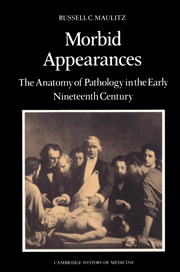Book contents
- Frontmatter
- Contents
- Dedication
- Preface
- Introduction: Ouverture: Bichat's head
- PART ONE PARIS
- 1 Genesis of a tradition
- 2 Pathology and the Paris faculty
- 3 Pathology in the middle
- 4 The center holds
- PART TWO CHANNEL CROSSING
- PART THREE LONDON
- Conclusion: A language of morbid appearances
- Appendix: Transcription and translation of Figure 1.1
- Notes
- Selected bibliography
- Index
1 - Genesis of a tradition
Published online by Cambridge University Press: 22 September 2009
- Frontmatter
- Contents
- Dedication
- Preface
- Introduction: Ouverture: Bichat's head
- PART ONE PARIS
- 1 Genesis of a tradition
- 2 Pathology and the Paris faculty
- 3 Pathology in the middle
- 4 The center holds
- PART TWO CHANNEL CROSSING
- PART THREE LONDON
- Conclusion: A language of morbid appearances
- Appendix: Transcription and translation of Figure 1.1
- Notes
- Selected bibliography
- Index
Summary
I believe only in French culture, and regard everything else in Europe which calls itself “culture” as a misunderstanding. I do not even take the German kind into consideration.
– Friedrich Nietzsche, Ecce Homo (1888)Was the veneration of Bichat a matter of mere expediency, occasioned by the need to move a few bones? How did this young outsider's career come to assume, after his premature death, an almost totemic value? Much of the answer lies in the structure of the French medical community in the postrevolutionary period. In life, as we have seen on the one hand, Bichat was never a central figure in that community. But he fashioned a career, on the other hand, that embodied key features of an emerging professional culture. For decades to come, the image his life and work conjured up was a tightly woven tapestry of the medical and surgical concerns knit together by the revolution. Bichat's memory bound them together still further. The full extent of how it did so is the central concern of this chapter and Chapters 2 through 4.
MEDICAL COMMUNITIES: THE PROFESSIONAL STAGE
Xavier Bichat arrived in Paris at an explosive time in the history of French institutions.
- Type
- Chapter
- Information
- Morbid AppearancesThe Anatomy of Pathology in the Early Nineteenth Century, pp. 9 - 35Publisher: Cambridge University PressPrint publication year: 1987
- 2
- Cited by



